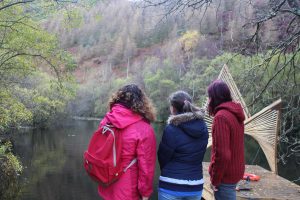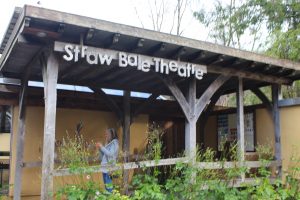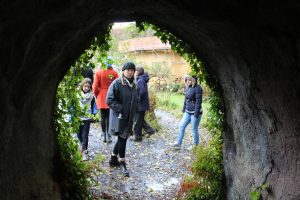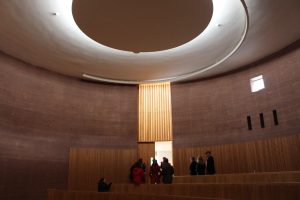Field Trip to the Centre for Alternative Technology

This week’s blog is by Frances McManus, a second-year student taking a BA in Anthropology and Chinese Studies

At the Centre for Alternative Technology in Machynlleth, we had an overnight stay which was both educational and (for me) very refreshing. We were given a tour of the grounds, background information on CAT, a lecture on the goal of a Zero Carbon Britain, as well as informal talks about sustainable buildings and gardening.
 CAT was started in the 70s by a group who wanted to show a different, more sustainable way of living. The site was originally a shale quarry and today still most of the grounds sit on shale waste, which many of the buildings made use of. Today CAT is an institute with a great focus on education, offering both short courses and a Graduate School for many topics within sustainability.
CAT was started in the 70s by a group who wanted to show a different, more sustainable way of living. The site was originally a shale quarry and today still most of the grounds sit on shale waste, which many of the buildings made use of. Today CAT is an institute with a great focus on education, offering both short courses and a Graduate School for many topics within sustainability.
We walked up to see the reservoir which provides the water that CAT consumes AND uses to create some of its energy needs. We learned about how the water for consumption is piped down to sand-beds for filtration, after which UV light is used to kill bacteria. This is unlike most of Britain’s domestic water supplies which go through multiple stages and (usually) the addition of chemicals. After use the drained water from CAT is piped further down the hill (all movement uses gravity which does not require labour or energy) into reed-beds which naturally clean the water, removing things like phosphates and nitrates, so that the water quality is good enough to return to the river.
 The water system is one shining example CAT offers as to how we, and countries like the UK, can change our methods to create more sustainable and efficient living systems. Many of the other examples we saw on site were buildings, such as the WISE (Welsh Institute for Sustainability Education) building which we spent the night in. I loved the WISE building. From the moment we entered, everything felt clean and fresh in a way that is absent in my own home, or in my uni hall. The building features wooden floors, doors, and outdoor walkways, all of which is untreated wood sourced locally. The walls are made from more sustainable materials than is the norm – lime is used instead of cement, hemp for insulation – meanwhile the design of each room maximises daylight to reduce the need for electricity. The theatre is a major feature, as it is the tallest ‘round earth’ structure in the UK. It is a circle of high red-brown walls which are very heat efficient (absorbing and releasing it slowly), while also ensuring that one day when the building is torn down or abandoned, the walls can simply return to the ground with no need for treatment.
The water system is one shining example CAT offers as to how we, and countries like the UK, can change our methods to create more sustainable and efficient living systems. Many of the other examples we saw on site were buildings, such as the WISE (Welsh Institute for Sustainability Education) building which we spent the night in. I loved the WISE building. From the moment we entered, everything felt clean and fresh in a way that is absent in my own home, or in my uni hall. The building features wooden floors, doors, and outdoor walkways, all of which is untreated wood sourced locally. The walls are made from more sustainable materials than is the norm – lime is used instead of cement, hemp for insulation – meanwhile the design of each room maximises daylight to reduce the need for electricity. The theatre is a major feature, as it is the tallest ‘round earth’ structure in the UK. It is a circle of high red-brown walls which are very heat efficient (absorbing and releasing it slowly), while also ensuring that one day when the building is torn down or abandoned, the walls can simply return to the ground with no need for treatment.
 We shared twin en-suite bedrooms which were impressively warm at night, showing just how efficient the building is. This was a highlight of the visit for me, as it was wonderful to have a long night’s sleep during reading week to recover for the second half of term. I slept more on this trip than any night so far this year, I would have loved to stay longer.
We shared twin en-suite bedrooms which were impressively warm at night, showing just how efficient the building is. This was a highlight of the visit for me, as it was wonderful to have a long night’s sleep during reading week to recover for the second half of term. I slept more on this trip than any night so far this year, I would have loved to stay longer.
Nice post – thanks Frances.